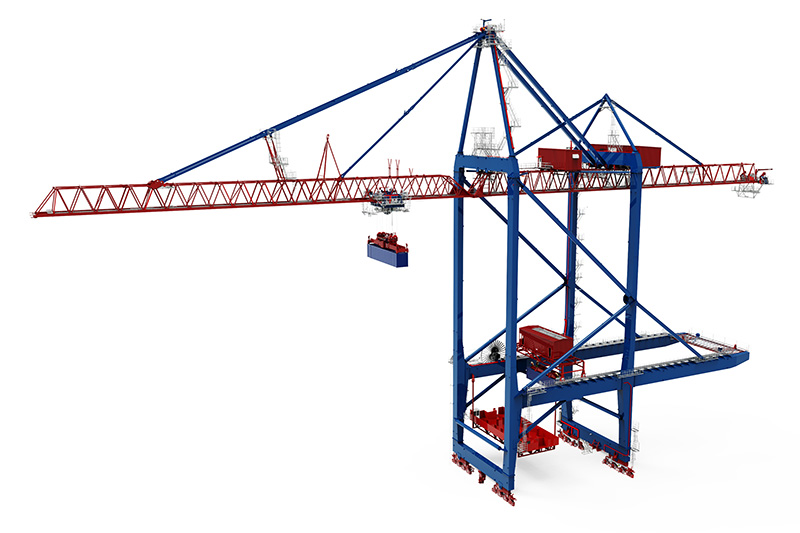Crane automation has seen significant advancements in recent years, particularly in the area of remote control. This technology allows operators to control cranes from a distance, improving safety and efficiency on construction sites. In this article, we will explore the latest advancements in crane automation and the benefits they bring to the industry.
The Evolution of Crane Automation: How Remote Control is Revolutionizing the Industry
In recent years, the crane industry has witnessed a significant evolution with the introduction of remote control technology. This innovation has revolutionized the way cranes are operated and has brought about numerous benefits for the industry. Remote control allows operators to control cranes from a safe distance, eliminating the need for them to be physically present in the crane cabin. This not only enhances safety but also increases efficiency and productivity. Additionally, remote control technology enables operators to have a better view of the working area, improving accuracy and precision. With the continuous advancements in remote control technology, the crane industry is set to experience further improvements in safety, productivity, and overall performance.
Remote Control Technology: Enhancing Safety and Efficiency in Crane Operations

Remote control technology has revolutionized crane operations by enhancing both safety and efficiency. With remote control, operators can now control cranes from a safe distance, reducing the risk of accidents and injuries. This technology allows operators to have a better view of the entire work area, enabling them to make more informed decisions and avoid potential hazards. Additionally, remote control technology improves efficiency by eliminating the need for manual operation, reducing downtime and increasing productivity. It also allows for precise and accurate movements, ensuring that loads are lifted and placed with precision. Overall, remote control technology is a game-changer in the crane industry, making operations safer and more efficient.
The Benefits of Crane Automation: Increased Productivity and Reduced Downtime
Crane automation offers numerous benefits, including increased productivity and reduced downtime. By automating crane operations, companies can streamline their processes and improve efficiency. Automated cranes can perform tasks with precision and accuracy, eliminating human errors and reducing the risk of accidents. This not only enhances productivity but also ensures the safety of workers. Additionally, automation allows for continuous operation, minimizing downtime and maximizing output. With automated cranes, companies can optimize their workflow and meet production targets more effectively. Overall, the adoption of crane automation can significantly improve productivity and reduce downtime, leading to increased profitability for businesses.
Remote Control vs. Traditional Crane Operation: A Comparison of Efficiency and Cost-effectiveness
In today’s construction industry, the use of remote control technology in crane operation is becoming increasingly popular. This article aims to compare the efficiency and cost-effectiveness of remote control operation versus traditional crane operation. Remote control operation allows operators to control cranes from a safe distance, reducing the risk of accidents and injuries. It also offers greater precision and maneuverability, resulting in faster and more efficient work. Additionally, remote control operation eliminates the need for additional personnel on the ground, reducing labor costs. However, the initial investment in remote control technology can be expensive. Overall, remote control operation offers numerous benefits in terms of efficiency and cost-effectiveness, making it a viable option for construction companies.
Overcoming Challenges: Implementing Remote Control Systems in Crane Automation
Implementing remote control systems in crane automation can present several challenges that need to be overcome. One of the main challenges is ensuring a seamless and reliable communication between the remote control device and the crane. This requires the use of advanced wireless technologies and protocols that can handle the high data transmission rates and provide a stable connection. Another challenge is the integration of the remote control system with the existing crane automation infrastructure. This involves adapting the control interfaces and protocols to ensure compatibility and smooth operation. Additionally, safety is a crucial aspect that needs to be addressed when implementing remote control systems in crane automation. Measures such as encryption and authentication protocols should be implemented to prevent unauthorized access and ensure the security of the system. Overall, overcoming these challenges is essential to successfully implement remote control systems in crane automation and improve efficiency and safety in crane operations.
The Future of Crane Automation: Exploring the Potential of Artificial Intelligence and Machine Learning
Artificial intelligence (AI) and machine learning (ML) have the potential to revolutionize the future of crane automation. With advancements in technology, cranes can now be equipped with AI and ML algorithms to enhance their efficiency and safety. AI can enable cranes to make intelligent decisions based on real-time data, optimizing their operations and reducing the risk of accidents. ML algorithms can analyze historical data to identify patterns and predict maintenance needs, allowing for proactive maintenance and minimizing downtime. Additionally, AI-powered computer vision systems can improve crane operators‘ visibility and accuracy, further enhancing safety. The integration of AI and ML in crane automation holds immense potential for increased productivity, cost savings, and improved safety in the construction and logistics industries.
Conclusion
In conclusion, advancements in remote control technology have greatly improved the efficiency and safety of crane automation. Remote control allows operators to have a better view of the work area and make precise movements with ease. With further advancements and integration of artificial intelligence, the future of crane automation looks promising in terms of increased productivity and reduced risks.
What is crane automation?
Crane automation refers to the use of technology and remote control systems to operate cranes without the need for direct human intervention.
What are the benefits of crane automation?
Crane automation offers several benefits, including increased safety, improved efficiency, reduced labor costs, and the ability to operate cranes in hazardous or hard-to-reach areas.
How does remote control work in crane automation?
Remote control systems in crane automation use wireless communication technology to transmit commands from a remote operator to the crane’s control system, allowing for precise and real-time control of the crane’s movements.
What advancements have been made in crane automation?
Advancements in crane automation include the development of sophisticated control algorithms, integration with other automation systems, improved safety features, and the use of advanced sensors and cameras for enhanced visibility.
Is crane automation suitable for all types of cranes?
Crane automation can be implemented in various types of cranes, including overhead cranes, tower cranes, mobile cranes, and gantry cranes. However, the feasibility and complexity of automation may vary depending on the specific crane and its intended applications.
Are there any limitations or challenges associated with crane automation?
While crane automation offers numerous benefits, there are some limitations and challenges to consider. These may include initial setup costs, potential technical issues, the need for skilled operators to manage the automation systems, and regulatory compliance requirements.

